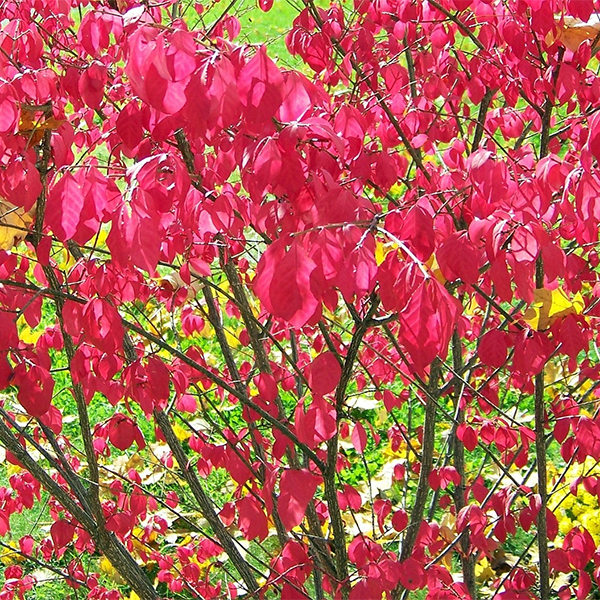
As early as mid-October and continuing through much of November, it’s ubiquitous throughout the northeastern USA. This time of year we can’t help but remark at the brilliant, intensely-red foliage of burning bush (Euonymus alatus) and its cultivars punctuating countless home landscapes, clustered in colonies alongside our roadways, peppering open fields, and spreading into the woods. In this region it often forms dense thickets in more heavily-wooded locations, where its fall color is a more-muted pink.
Burning bush has been among the most popular and least expensive of any shrub to grow; it tolerates shearing, neglect and abuse, and stays attractive even with minimal care, so homeowners have planted it with abandon. Pest-free and with few predators, it has a fibrous root system that thrives even in dry conditions, establishing readily in most any soil. Over the decades burning bush and its cultivars have been so widely planted that it seems like the “ideal” choice for your yard—but let’s not jump to conclusions!
Native to Asia, the species grows to about 15 ft. high and wide, each stem adorned with prominent corky “wings”, and it spreads aggressively as birds consume and “replant” its orange-purple seeds. Its most common cultivar is ‘Compacta’, a slower and slightly-smaller-growing shrub with less-pronounced stem-ridges, but much more brilliant scarlet-red fall foliage. Showing only bare stems in winter, its clean dark green summer leaves vary in timing their color change, depending upon soil, sun and moisture conditions.
Introduced to the USA in the mid-19th century, burning bush and its progeny have taken many decades to escape, but they’ve now become naturalized just about wherever we go throughout the northeast. Only in recent years has it unmistakably become a thug, increasingly establishing thickets that dominate and choke-out native plants, even spreading into undisturbed natural areas. Massachusetts and several other northeastern states have now deemed Euonymus alatus and its cultivars “invasive” and prohibit selling and planting the species.
Because it is now such a widely-dispersed species, eradication of all plants is not feasible, so we can expect be seeing its brilliant fall colors for many years to come. But for the sustainable landscape, here are some less-aggressive alternatives with similar features, readily available at garden centers:
- Blueberry (Vaccinium corymbosum and cultivars)
- Redvein Enkianthus (Enkianthus campanulatus and cultivars)
- Sweetspire (Itea virginica)
- Chokeberry (Aronia arbutifolia)
- Witch alder (Fothergilla species and cultivars)
- Sumac (various Rhus species and cultivars)
- Oakleaf hydrangea (Hydrangea quercifoila)
DOWNLOAD THE BURNING BUSH ALTERNATIVES PLANT LIST
No legislation or regulation currently requires homeowners and landowners to remove burning bush from their property. But you can do your part for environmental correctness by pulling-out unwanted seedlings as they appear before they become mature and produce seed of their own.









